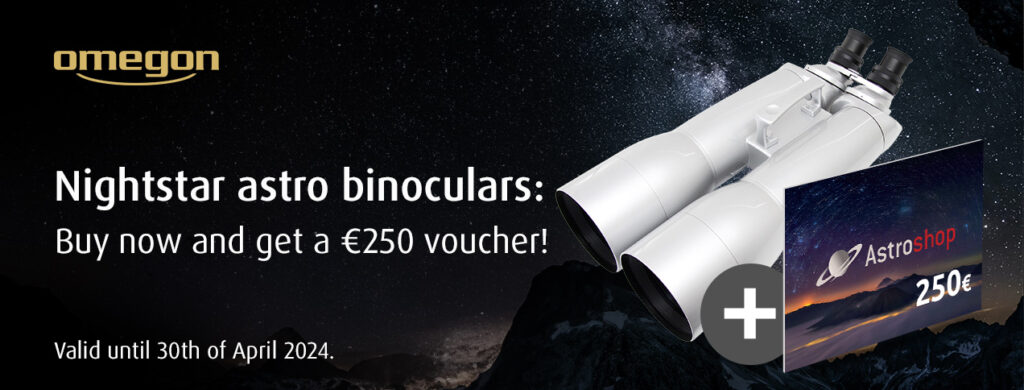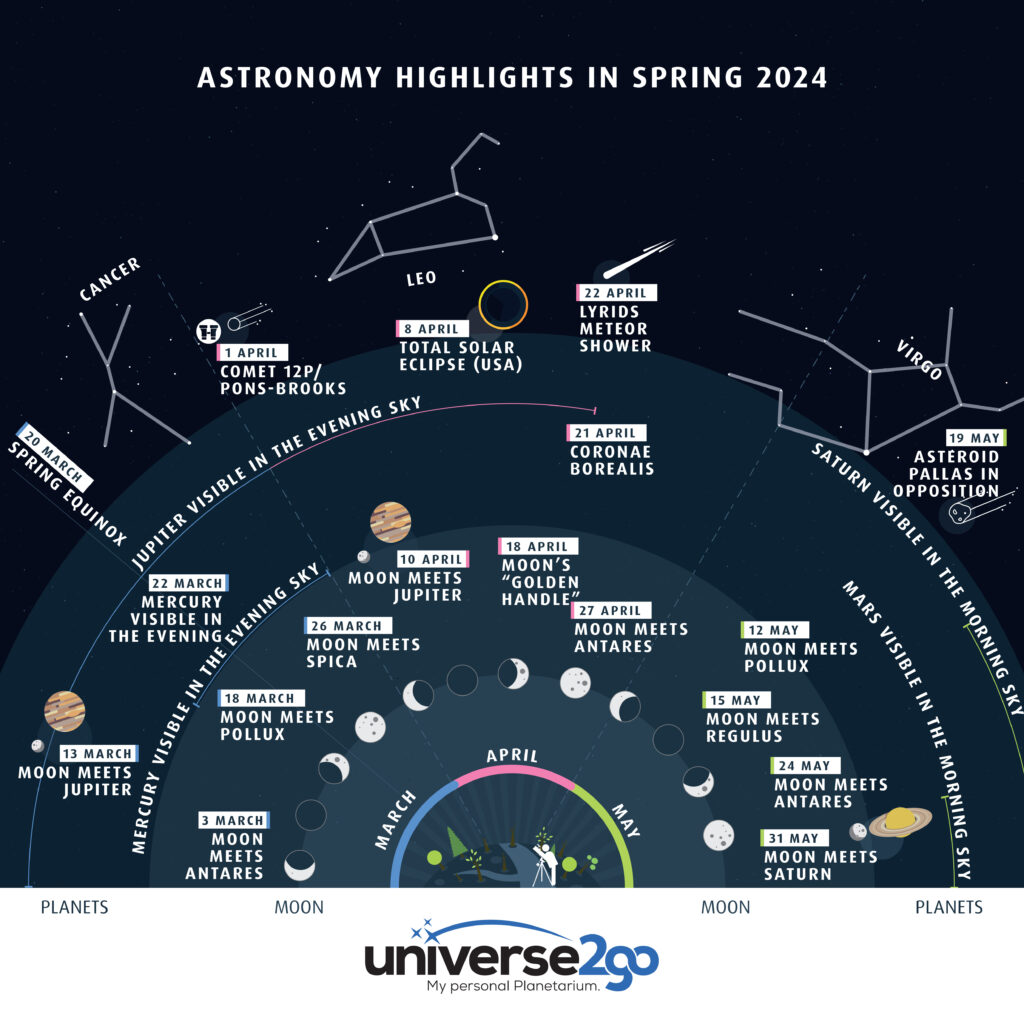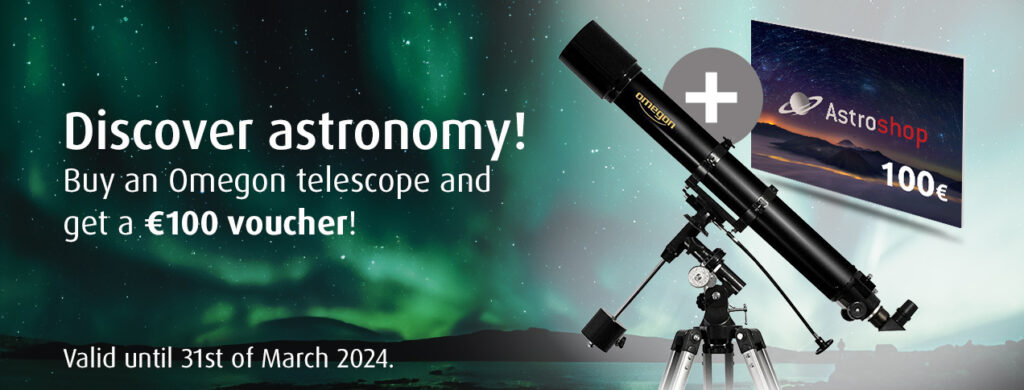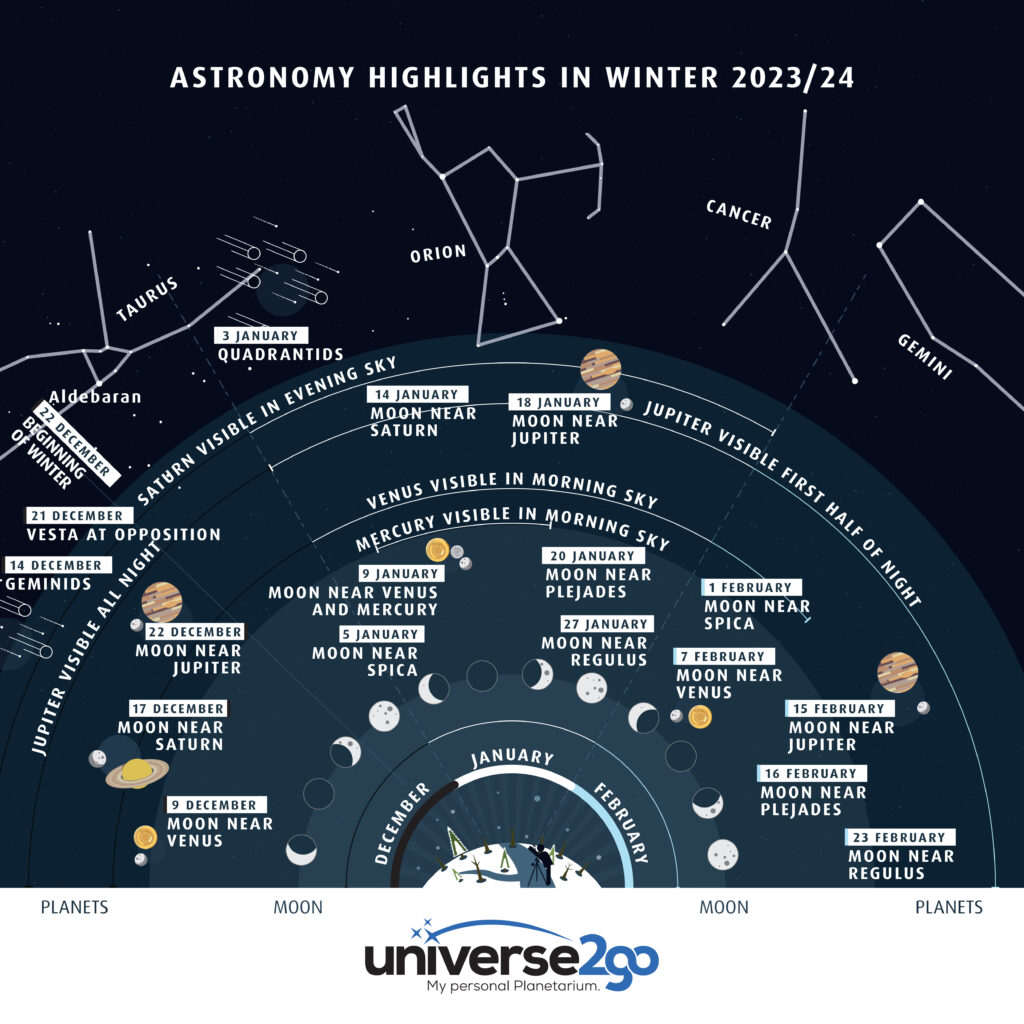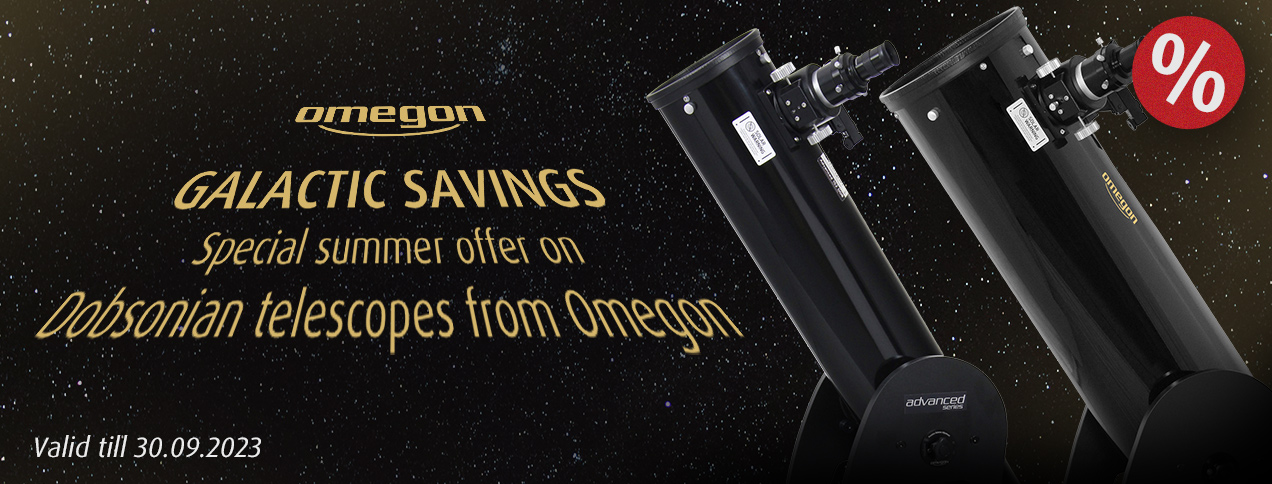Discover exciting celestial events in autumn 2023. Here are the highlights that are worth observing.
There are some really thrilling celestial events awaiting us in autumn 2023 that we really should not miss. From the best morning visibility of the planet Mercury, to a partial lunar eclipse, to the occultation of gleaming Venus by our Moon. Once again, the next three months have plenty of excitement in store. This infographic shows you all the highlights of the coming months of September, October, and November, and the text below the graphic gives you more details. I wish you lots of observing fun.
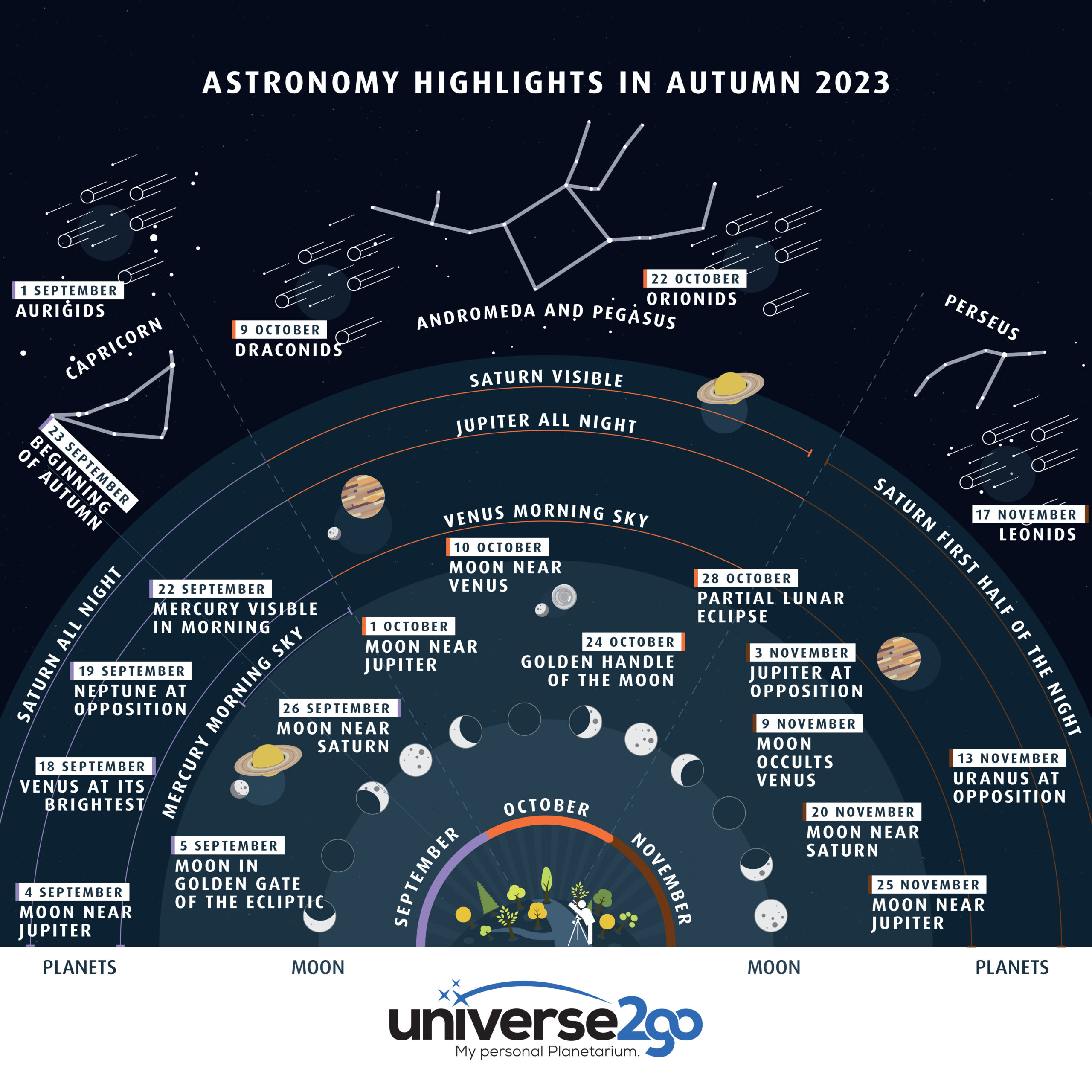
SEPTEMBER
01/09 The Aurigids
During the night of 1 September, hobby astronomers can observe a special celestial event in the night sky: the Aurigids. This is an impressive meteor shower that appears to originate from the constellation of Auriga. The Aurigids are known for their bright and fast meteors, which travel at up to 65 kilometres per second. It is worth for us all to get up early or stay awake late, so no one misses this impressive event in the night sky!
04/09 Conjunction of the Moon and Jupiter
We are presented with another highlight on 4 September: the Moon and the gas giant Jupiter meet in the night sky. These two celestial bodies appear above the eastern horizon in the late evening. They climb higher over the course of the night, and will remain until the morning hours, eventually fading in the splendour of the new morning.
05/09 The Moon at the Golden Gate of the Ecliptic
On 5 September the Moon crosses the Golden Gate of the Ecliptic. This phenomenon is a must-see for all celestial observers and offers a wonderful opportunity for observing with the naked eye.
The Golden Gate is neither an object nor a celestial event in itself, but an asterism in the constellation of Taurus. Its luminous pillars are formed by the open clusters Hyades and Pleiades.
The ecliptic, the apparent path of the Sun, runs along this gateway, through which our Moon and the planets appear to pass.
18/09 Venus at its brightest
Venus is at its brightest on 18 September. The evening star shines especially bright with a magnitude of -4.7, and can be seen to the east in the early morning hours. Venus appears almost like a spotlight because it is so bright, and we can still see it in the sky for some time – even as dawn begins to break.
19/09 Neptune at opposition
Neptune is at opposition to the Sun on 19 September, making it visible all night long. Hobby astronomers can observe the gas planet with a telescope, it appears small but intense in colour.
22/09 Mercury visible in the morning
Keep an eye out if you are an early riser! Mercury offers the best morning visibility of the year on 22 September. Back in January, the planet was hard to observe in the morning, but now we have a better chance. Shortly before sunrise, at around 05:50 CEST, the small planet is easily visible in the east, just above the horizon. Mercury is located in the constellation of Leo, so starting from the star Regulus, you can orient yourself around 10 degrees in a north-east direction.
26/09 Conjunction of the Moon and Saturn
The Moon joins the ringed planet Saturn on the evening of 26 September. This meeting offers a picturesque sight, and a highlight for all celestial observers.
OKTOBER
1/10 Conjunction of the Moon and Jupiter
The paths of the Moon and Jupiter intersect once again. On 1 October we can marvel at this impressive event in the evening sky.
9/10 The Draconids
The Draconids shooting stars reach their peak on 9 October. This meteor shower originates from the constellation of Draco, which is located in a northerly direction above the Big Dipper. The number of shooting stars often varies from year to year. So, it is worth keep an eye out for them on different days at different times.
10/10 Conjunction of the Moon and Venus
Four days before the new Moon we can admire Venus and our Moon together in the morning sky. The two celestial bodies shine with a wonderful lustre above and below the star Regulus in Leo. An almost magical sight for every stargazer.
22/10 The Orionids
Meteor showers are lovely events for every avid star-gazer, the Orionids are no exception. They peak on 22 October and promise around 25 to 30 meteors per hour. However, the number of shooting stars often varies from year to year. To catch the best view of them, set your alarm clock and take a look outside in the early hours of the morning. A must for all shooting star fans.
24/10 Golden Handle on the Moon
On 24 October the Moon shows its most beautiful side: the Golden Handle is visible.
The flat light near the lunar terminator creates a breathtaking play of shadows and light. The Golden Handle is especially beautiful. For several hours, the peaks of Monte Jura are illuminated by the rays of the Sun, while the small Sinus Iridum valley is still in the shade. A veritable feast for the eyes that displays the Moon’s beauty in all its splendour.
28/10 Partial lunar eclipse
A special celestial event awaits us on the evening of 28 October: a partial lunar eclipse. The Moon moves into the Earth’s umbra at 21:35 CEST. However, the eclipse magnitude is quite low at only 12.7%. Nevertheless, the eclipse offers a beautiful, unmissable experience in the early evening. So, keep an eye out for this fascinating spectacle in the night sky!
More about the formation of lunar eclipses can be found in our magazine article “How does a lunar eclipse occur?”
NOVEMBER
03/11 Jupiter at opposition
Jupiter is at opposition to the Sun on 3 November. The gas giant is visible all night long and reveals itself in all its glory. This is a special event for all stargazers and hobby astronomers that you should not miss. Of course, you can also observe the gas giant in the coming weeks – not just today. But the planet appears much larger and it shines particularly brightly when it is at opposition. You can see the characteristic dark stripes on Jupiter’s surface with a telescope, along with its four largest moons: Io, Europa, Ganymede, and Callisto.
09/11 The Moon occults Venus
A special event awaits us on the morning of 9 November at 10:55 CEST: an occultation of Venus by the Moon. This is a very rare and impressive spectacle that is definitely not to be missed. It is the astronomical highlight of 2023 for advanced hobby astronomers. In order to observe this occultation, focus your telescope on the illuminated sickle Moon at around 10:50. The Moon will occult Venus from its bright side. The whole spectacle lasts around 80 minutes.
13/11 Uranus at opposition
Uranus is at opposition to the Sun on 13 November. The distant planet is visible all night so it is a great opportunity to observe it with your telescope. Despite its tiny size of 3.8 arcseconds, when you look for it with your telescope you will be able to distinguish it from a star because its surface looks wide and not point-shaped. In addition, its greenish colour is easily recognisable.
17/11 The Leonids
On the night from 16 to 17 November it is once again time – the Leonids reach their annual maximum and ensure a beautiful celestial event. Together with the Perseids, they are among the most well-known shooting stars that can be observed annually from Earth. There are even some years when the meteors fall from the sky in such abundance that it is almost like a rain shower. This spectacle is repeated every 33 years when the Earth comes into contact with the Leonids’ trail. But they will produce up to 20 meteors per hour even in normal years, which is an unmissable experience.
20/11 Conjunction of the Moon and Saturn
The Moon joins the ringed planet Saturn once again on the evening of 20 November. It is a fascinating sight that will accompany us in the evening sky.
25/11 Conjunction of the Moon and Jupiter
At the end of the month, on 25 November, we have another chance to marvel at an encounter between the Moon and Jupiter in the night sky.


